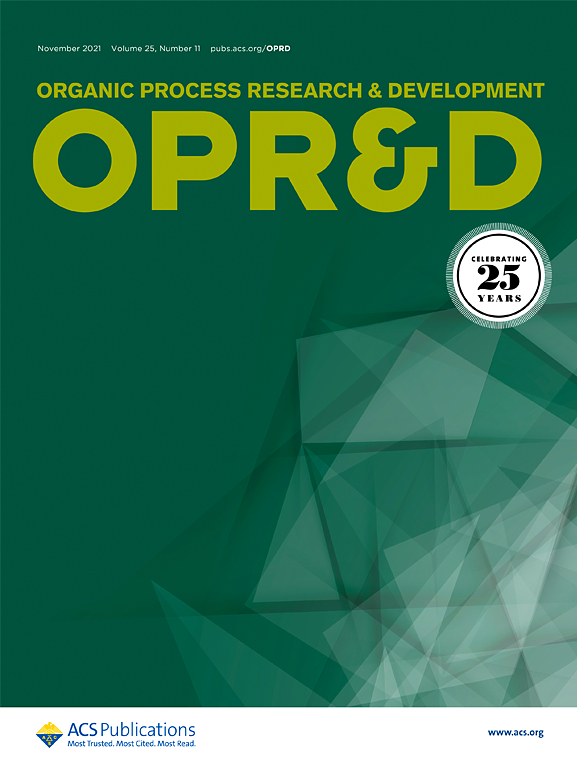可溶性环氧化物水解酶抑制剂t-TUCB与l-精氨酸的共晶固体分散
IF 3.5
3区 化学
Q2 CHEMISTRY, APPLIED
引用次数: 0
摘要
可溶性环氧化物水解酶(sEHIs)抑制剂已被用于治疗人类和动物的各种疾病。因此,各种sEHIs已经在一些临床试验中进行了研究。在这里,我们报道了与氨基酸l-精氨酸的sEHI t-TUCB共晶固体分散体的发展。t-TUCB具有很低的水平衡溶解度(0.031±0.013 μg/mL, pH为6.6的去离子水),但含有游离羧酸。因此,将t-TUCB转化为相应的钠盐提高了水溶性(1.2 mg/mL)。然而,钠盐容易形成不溶性t-TUCB钠盐聚集体,这对钠盐的规模化生产存在问题。然而,加入l-精氨酸可以使t-TUCB钠盐聚集体分解。此外,l-精氨酸的碱性使我们可以直接制备t-TUCB的固体分散体,形成共晶体系。t-TUCB与l-精氨酸以1:3的比例共晶固体分散体(t-TUCB/Arg(1:3)固体分散体)不仅提高了t-TUCB的水溶性(2.2 mg/mL)和溶解率(10 min溶出80%),而且解决了t-TUCB与钠盐相关形成不溶性重聚集体的问题。因此,获得的t-TUCB/Arg(1:3)固体分散体的生物利用度为87.1%,口服后可减轻lps诱导的大鼠疼痛。本文章由计算机程序翻译,如有差异,请以英文原文为准。

Coamorphous Solid Dispersion of a Soluble Epoxide Hydrolase Inhibitor t-TUCB with Amino Acid l-Arginine
Inhibitors of soluble epoxide hydrolase (sEHIs) have been of interest for treating various diseases in humans and animals. Therefore, various sEHIs have been investigated in several clinical trials. Here, we report the development of a coamorphous solid dispersion of an sEHI t-TUCB with the amino acid l-arginine. t-TUCB has a very low aqueous equilibrium solubility (0.031 ± 0.013 μg/mL in pH 6.6 DI water) but possesses free carboxylic acid. Thus, converting t-TUCB to the corresponding sodium salt improved the water solubility (1.2 mg/mL). However, the sodium salt tended to form insoluble t-TUCB sodium salt aggregates, which is problematic for the scale-up of the sodium salt. However, adding l-arginine can deaggregate t-TUCB sodium salt aggregates. Moreover, the basicity of l-arginine allows us to prepare solid dispersion of t-TUCB directly, which forms a coamorphous system. The coamorphous solid dispersion of t-TUCB with l-arginine at a ratio of 1:3 (t-TUCB/Arg (1:3) solid dispersion) not only improved the water solubility (2.2 mg/mL) and dissolution profile (>80% in 10 min) of t-TUCB but also solved the problem of forming insoluble heavy aggregates associated with the sodium salt of t-TUCB. Therefore, the t-TUCB/Arg (1:3) solid dispersion obtained showed 87.1% bioavailability and alleviated LPS-induced pain in rats when orally administered.
求助全文
通过发布文献求助,成功后即可免费获取论文全文。
去求助
来源期刊
CiteScore
6.90
自引率
14.70%
发文量
251
审稿时长
2 months
期刊介绍:
The journal Organic Process Research & Development serves as a communication tool between industrial chemists and chemists working in universities and research institutes. As such, it reports original work from the broad field of industrial process chemistry but also presents academic results that are relevant, or potentially relevant, to industrial applications. Process chemistry is the science that enables the safe, environmentally benign and ultimately economical manufacturing of organic compounds that are required in larger amounts to help address the needs of society. Consequently, the Journal encompasses every aspect of organic chemistry, including all aspects of catalysis, synthetic methodology development and synthetic strategy exploration, but also includes aspects from analytical and solid-state chemistry and chemical engineering, such as work-up tools,process safety, or flow-chemistry. The goal of development and optimization of chemical reactions and processes is their transfer to a larger scale; original work describing such studies and the actual implementation on scale is highly relevant to the journal. However, studies on new developments from either industry, research institutes or academia that have not yet been demonstrated on scale, but where an industrial utility can be expected and where the study has addressed important prerequisites for a scale-up and has given confidence into the reliability and practicality of the chemistry, also serve the mission of OPR&D as a communication tool between the different contributors to the field.

 求助内容:
求助内容: 应助结果提醒方式:
应助结果提醒方式:


